When Were Round Head Nails First Used
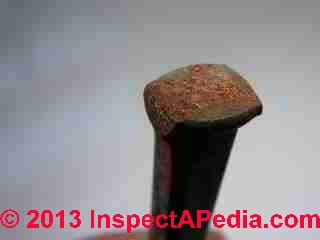 Chronological History of Nails
Chronological History of Nails
Antique Wooden, Forged & Cutting Smash Age & Use - Home Folio
- Mail service a QUESTION or Comment about determining building age by examining its nails & other hardware
InspectAPedia tolerates no conflicts of interest. Nosotros take no relationship with advertisers, products, or services discussed at this website.
Antiquarian & modern Nails, including wood treenails, hand-wrought nails, cut nails, wire nails, are compared and described here.
We give a chronology: the history of nails, types & methods of fabrication, and we describe antique and modern cut nails focusing on tree nails, wrought nails, and cutting nails used in forest frame construction or interior finishing or carpentry piece of work.
We include useful dates for the industry of different boom types along with supporting inquiry for diverse countries from Australia and the U.K. to the U.S. to New Zealand.
The history, number and types of nails is both interesting and enormous, fifty-fifty if nosotros confine our discussion to just those used in the construction of buildings. We continue to add together examples and photographs hither and welcome readers to CONTACT Usa with contributions or suggestions.
This article series describes and illustrates antique & modern hardware: door knobs, latches, hinges, window latches, hardware, nails & screws tin help determine a building'due south age past noting how those parts were fabricated: by manus, by motorcar, by later generations of machine.
Nosotros also provide an ARTICLE Alphabetize for this topic, or yous can try the page top or bottom SEARCH BOX as a quick manner to find data you need.
History of Nails & Building Hardware
 Blast Photographs & Nails as Indicators of Building Age
Blast Photographs & Nails as Indicators of Building Age
As a carpenter's nails are divided into wrought nails and cutting nails; so mankind may be similarly divided. Lilliputian Flask was 1 of the wrought ones; made to clinch tight and last long. - Herman Melville, Moby Dick.
An examination of nails and fasteners and other building hardware is a complimentary effort useful in determining the age of a building and its components.
[Click to enlarge any prototype]
A close observation of the type of fasteners used in a building is one of the almost popular means of estimating its age.
The three types of nails found in North American construction include mitt wrought nails, automobile cut nails, modern round "wire" nails.
Nelson (NPS) and other nail chronologists bespeak out, however that a wealth other details tin describe the engagement of production and use of each of those three general blast types. In turn, blast details can establish the time of original construction of a edifice and the time of modifications to the structure.
In addition to nails, edifice material, wood saw cut marks, and other hardware details can farther assist in determining building age.
The nail shown above in the photo and detailed further below was hand-fabricated in the Northeastern U.Due south. before 1800 merely could be still earlier.
To provide a chronology of the product and types of nails we first depict wooden nails or "tree nails" followed by a chronological listing of useful dates for fe nails.
Wooden nails - Tree Nails or Treenails, Post & Axle Construction
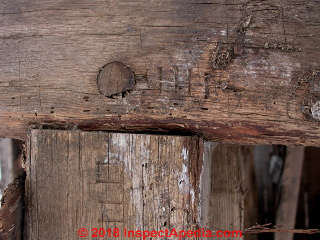 At AGE of a Edifice, HOW to Decide we notation the following:
At AGE of a Edifice, HOW to Decide we notation the following:
Post and beam construction (1700 - est. in North America): (timber framing) uses horizontal and vertical timbers that are connected (joined) using mortise and tenon joints pinned with woods pegs (treenails).
Timber frame construction initially used hand hewn beams, later manually or mechanically sawn beams cut by a pit saw. Later timber frame beams were sawn in mills using circular saws.
Timber framing using postal service and beam construction with mortise and tenon joint connections was used in Europe for at least 500 years before it was first employed in North America.
In our photograph you lot can see the round sawn-off peg that secured the tenon of the lower vertical post into the mortise that had been cut into the horizontal beam.
The posts and beams were cut to size, mortises and tenons were cut, and the builders marked the corresponding articulation components with numbers or letters - in my photo you tin see the
I I I I
and
_
_
_
_
stamped into both the vertical post and horizontal beam to aid in associates.
Below you lot tin can see the Treenail joining ii rafters at the ridge of this 1790 domicile nigh Poughkeepsie New York.

By 1650 a typical timber frame edifice used multiple bents and girt beams, may have been more than than one story tall, and included an exterior made of horsehair-reinforced cement stuccoed over hand-separate lath.
More examples of uses of wooden pegs or treenails are at
- FRAMING MATERIALS, Age, Types
- FRAMING METHODS, Age, Types
- HEWN BEAMS & PLANKS
- SAW & AXE CUTS, TOOL MARKS, AGE
- SAW Bract SIZE CALCULATED from SAW MARKS
A Tacky Little History of Fe Nails
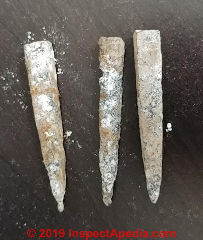 Blast Head & Smash Body Details Assist Set Nail Age
Blast Head & Smash Body Details Assist Set Nail Age
Photo: sprites, small headless mitt-wrought nails, discussed in more detail
at NAILS & HARDWARE, AGE FAQs.
Adapting from various sources including Nelson'south article cited beneath we give a crude chronology of types and uses of nails, focusing on North America but including other before nail production and use likewise.
Earliest Nails - 300 B.C.
The Mansfield, Massachusetts Tremont Nail company's historical notes (cited below) betoken that nails have been made (by hand) dating back to 300 B.C.
Nails in the 1400s
The denomination of nail sizes based on the price per 100 nails (due east.g. ten penny nails or 10d nails) dates from the 1400s.
In medieval England nails were made into a great variety of special shapes and sizes and sold by the hundred, e.1000., 8d (pence) per 100 nails. From this practice adult the classification of nail sizes according to their toll per hundred, a organisation which seems to accept been established past the fifteenth century. In 1471 for example, "fippenynayl" were just 4d per 100. In 1477 "xpenynayll" were only 8d per 100; and in 1494 "sixpenynayle" were 5d per 100.
Nails in the 1590s
The 1500s saw the kickoff nail producing machines - First Nail Making Machines - 1590 Slitting Mills
The roots of producing nails past motorcar date from 1590.
Nails in the 1600s - 1900s: paw wrought nails
Mitt wrought nails were used for construction and afterwards more than for decoration.
The scarcity of nails in colonial Virginia was reflected in a statute enacted in 1645 to prohibit settlers from called-for down old buildings for their nails. Some nails were made in the colonies in the seventeenth and eighteenth centuries, but despite this local production very large quantities of nails were imported during the same menstruation.
Details are at NAILS, HAND WROUGHT
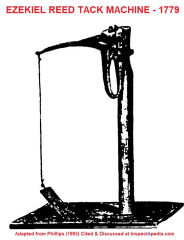 1766 - Iron Nails Used as Barter
1766 - Iron Nails Used as Barter
Although traditional Tahitian culture did non sanction extramarital sexual relations, inside 48 hours of Wallis'southward arrival, Tahitian husbands and fathers were encouraging their wives and daughters to swim out to the Dolphin and offering the sailors sex in exchange for iron nails.
Aware of the brisk merchandise in iron, afterward explorers such as Captain James Cook brought supplies of nails and hoop fe with them to castling for freshwater, fish, pork, and vegetables.
Cook's visits [to Tahiti] in April 1769, August 1773, and Baronial 1777 only heightened the islanders' desire for atomic number 26 and other western goods. . (Denver, 2013 Tahiti, p. 682-683).
1775-1783 Nails During the American Revolution
The colonists shifted to local product of nails and boom import from England was reduced or ceased altogether.
1779 First "Cut Nails" in N America
1779 - 1780 Hand-Operated blast cutting machines.
Ezekial Reed's 1779 Tack Machine, (illustrated above, Phillips-1993) the first machine-made tacks,was operated by a foot treadle and was able to produce up to 3,000 tacks a day. Wedge-shaped iron blanks were cut by shears from a loop of strip hoop (such as used to construct wooden barrels).
The iron blank was placed tip-down in the jaws of the tack machine with the tiptop protruding enough to be flattened by a hammer to course a head.
1788 - Adam Rogers auto to cut nails from iron hoops
 1772 - 1820: In North America early auto cut nails
1772 - 1820: In North America early auto cut nails
Dating from 1590 in England, as the earliest study of nail production, the earliest reported cut nails in America are reported to take been cut, substantially by-paw, past Darrow in 1772 (Federal Writers Project 2013) with other authors crediting the Wilkinson brothers somewhat after, ca. 1783 (Benedict 1883).
Nelson notes the first generation of cut nail manufacturing involved cutting all nails from mutual sides with heads hammered on every bit a split product footstep.
The first nail making machines in N America appeared during the late 1700'south - earlier than one might have guessed.
The slitting mill, introduced to England in 1590, simplified the product of smash rods, just the real offset efforts to merchandise the nail-making procedure itself occurred between 1790 and 1820, initially in the United States and England, when diverse machines were invented to automate and speed upward the procedure of making nails from bars of wrought fe.
To a higher place are nails used to secure accordion lath - a plaster base of operations institute in a rural U.South. post-and-beam home in Wyoming Canton, New York.
These two nails are from unlike machines. Detect that the upper one has a rounded caput. A closer look might bear witness that the nail shank is constricted and rounded merely below the head: marks from the vise that gripped the nail during the head-forming pace.
The head on the lower nail is more-irregular.
More virtually the accordion forest board in this edifice and our estimate of the edifice age are
at Forest LATH, TYPES.
1789 - U.S. Congress sets duty on imported nails
1790 - U.South. Congress passes outset U.S. Patent Act - the second of two steps that encouraged development of smash making machines in North America.
1792 - Samuel Rogers (nephew of Adam Rogers) - expanded the hand-operated automobile-cut blast operation.
These nails have shanks with ii tapering and the other two parallel sides, cutting die burrs appearing on diagonally-contrary edges. (Phillips 1993). The cross-department of the nail shank is a "skewed rectangle" and the boom tips are rounded. Heads on these nails were manus-formed as a "T" or as a rose-faceted head.
1794 - Perkins Smash Cut Machine. Jacob Perkins, inventor of a water-powered nail-cutting motorcar, began producing machine-made cut nails in 1794 and in 1795 received the first U.S. nail-cutting motorcar patent. (Phillips 1993)
Perkins' machine, powered past h2o rather than by manus would have been capable of producing a greater quantity of nails per day.

1798 - Read Nail Cut Motorcar. Nathan Read produced cut nails at their Salem Iron Manufactory offset in 1798.
Details about both of these inventors, their nail making machinery, and smash properties are in our carve up guide to cut nails at
Boom ID & AGE: Cut NAILS - photos of types of cut nails and details well-nigh determining their age where we describe early boom-making machines in North America and include English and U.S. patents for such equipment.
 ...
... 
Our commencement illustration shows a skewed-shank auto-cut clapboard blast.
In our second analogy, (both adjusted from Phillips 1993) notation the rounded and narrowed shank just nether the head equally deformed when gripped in the machine vise to form the head (red pointer) and the irregular-shaped caput (bluish pointer) and likewise the rounded blast tips on both of these early on machine-made nails.
1805 - nowadays: nails made completely by motorcar
Past some sources nails made completely by machine, including the blast head, appeared as sprigs and brads equally early as 1805, and continue in employ to the present. (Nelson The states NPS cited below.)
Really? Phillips (1993) reports that actually cut nails made entirely by machine are credited to Jacob Perkins- cited to a higher place.
- 1806 - Blanchard Tack Making Motorcar - 1806
Thomas Blanchard was born on June 24th, 1788, in Sutton, Massachusetts, near Worcester. His first invention was a tack making car which he invented at age xviii and perfected over the next six years.
This made production of tacks, which Thomas and his blood brother had been previously engaged in making, easier and more efficient at a rate of five-hundred per minute.
- U.S. NPS cited below. - 1807 Read, Ezekiel nail cut machine: one machine producing both shank and head. Ezekiel Reed (un-related to Nathan) is credited with inventing the one-functioning nail cutting machine in 1807. (Phillips 1993).
- 1810 - 1820: cut nails were made cut from opposing sides and used heads hammered on equally a divide production step.
Cutting from opposing sides means that the shear cut that produced the nail was made from opposing sides of an iron or steel bare slab.
Take a look at the shear marks on your nail to see if they are both on one side or if they appear on opposing sides. See the "burrs" illustrated as adjusted from Nelson in the citations at the terminate of this article.
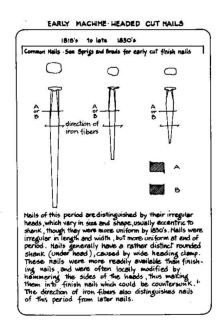
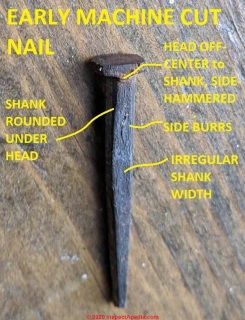
[Click to enlarge any image]
- 1815 - late 1830s: crude machine made or machine cutting nails, outset machine made heads.
Illustration in a higher place: properties of early machine-headed cut nails, - U.s.a. NPS, Lee Nelson (cited beneath).
Photo to a higher place: early auto cut blast photo, courtesy of reader J - 2020/05/23
[Click to enlarge any epitome]
Question: is this an early machine-cutting nail?

J said:
I was recently repairing an old dresser I had gotten from a thrift store and found some very onetime looking square nails, which led me here.
They appear to be early machine cut nails based on your photos. Is my assessment correct?
Moderator answer:
The observation that your nail is irregularly tapered from beneath the head, getting wider, then narrowing again, suggests that it's an early on machine-cut boom, maybe roughly between 1815 - 1839 according to Nelson in our references.
Blast ID & AGE: HAND FORGED NAILS
In the article above and too again at NAILS HAND-WROUGHT & REPRODUCTIONS nosotros note from Nelson'south research that ...
If your cutting nail is irregular in shank width and has the "A" type side burrs it's likely to have been made earlier the late 1830s.
- 1820s - 1830s: crude machine made heads
Earlier the 1830s the iron fibres in machine cutting nails ran across the nail shank, causing the nail to break off if the user tried to assure it'southward protruding end.
For this reason, earlier the 1830s and where nail clinching was needed carpenters connected to use mitt-wrought nails. (Nelson).
Cutting nails made before the late 1830s will typically have:
- an irregular and mayhap off-center head
- a head that may have been hammered to permit counter-sinking
- a shank of irregular width
- burrs that perhaps on opposing sides of the nail shank depending on the cut motorcar
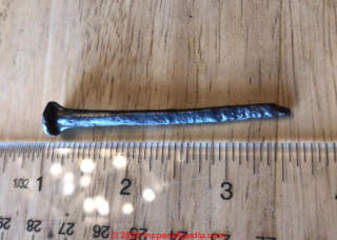 ...
... 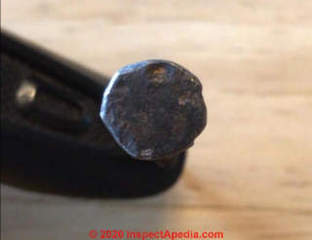
Above: photos of Dan Nelson's early machine-made nail discussed merely beneath.
Question: New England Nail estimated age 1810 +
2020/04/20 Dan Nelson said:
Hi,
I found this blast while metal detecting an quondam hayfield in northern Vermont.
The caput is round.
The offset quarter inch or so of the shank from the head is round-oval.
From there to the betoken, the nail is very square and tapered.
I practice non empathize why at that place are fins on the shank directly below the head. I have constitute coins I the area equally far back equally 1787.
I would like to exist able to know the rough age of this smash. Cheers.
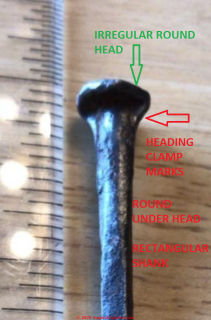
Reply: details of early machine made nails, rounded head & upper shank, rectangular lower shank
Dan,
Thank you for the helpful photos of your antique smash. My estimate of the age of your nail is 1830 or a bit older, with an "earliest" date of 1815.
On that folio I cite Lee Nelson:
- Nelson, Lee, Boom Chronology As An Aid to Dating Old Buildings, Technical Leaflet 48. Nashville: American Association for Country and Local History, 1968
and - Nelson, Lee H., NAIL CHRONOLOGY as an AID to DATING OLD BUILDINGS [PDF], U.S. National Park Service, Technical Leaflet No. 48. retrieved 2019/01/08, original source: npshistory.com/publications/smash-chronology.pdf
Looking carefully at the irregular-round nail head in your photograph and the compression marks just beneath the smash caput, the primeval we could date this nail might be 1815-1830,
or in my Stance, probably a bit later, as late as 1850. I retrieve some early on smash making machinery often had a longer life than ascribed by Nelson. In some communities, old nail making machine may accept, for a time, continued in production alongside later, more-sophisticated machines producing more-rounded and more-uniform nails.
Made in the U.Southward. in the East, this is an early machine-fabricated boom characterized, per Nelson, past its irregular-round head and the combination of a rounded shank and pinch marks from the smash heading clamp, transitioning to a rectangular shank for the remainder of the smash.
Your nail is large enough that it would non accept been later modified (by hammering the head) to convert to a "finishing nail" that could be countersunk. Instead this 3 one/two" long nail would accept been used every bit a structural connector.
In the U.S. the earliest manufactured nails (1790-1830) were operated by paw, later past water mills and yet afterwards past steam engines.
Considering the rounded upper nail shank looks regular I suspect this is i of the later members of "Early Automobile Headed Cut Nails" nails, 1830 - 1850 described by your namesake.
Nelson points out that these early machine-fabricated nails were more than readily available than machine-made finishing nails, and that they were oft irregular in both length and diameter or width - something you cannot see when we have simply one smash but that we might come across if we were examining multiple nails from an one-time New England building.
A close wait at the rectangular sides of the boom shank may show the remains of a long burr along the shank characteristic of early cutting nails. The burr remains on the side of the boom that was cut from a flat iron plate that was opposite the descending shear bract.
Tapering was produced by "wiggling" the iron plate side to side equally the shear descended to cut individual nails.
The irregular rounded head was fabricated in a subsequent step by showtime clamping the blast shank then that the head could be compressed - hence the rounded shank with compression marks on the upper part of the blast just under the nail head.
1810 - Present: Modernistic Car Fabricated Nails
Note direction of iron fibres in nails and spikes
Photos below: large iron spike found near Elmira, Ontario by Vern M shows laminar splitting along the length of the boom shank, giving an earliest date that some sources put at 1830.
The Perkins first cut nail motorcar patent (1795) was succeeded by an 1810 patent filed by the aforementioned inventor in England in 1810. That improved nail cutting machine produced nails with fibres along the length of the shank. (Phillips, 1993 citing English language Patent No. 3365, application dated July 26, 1810; specifications filed January 26, 1811.)
Then we have an earliest-engagement for nails like the one below, produced in the U.S., of 1810.
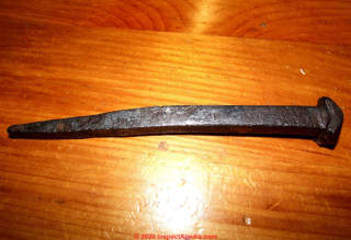 ...
... 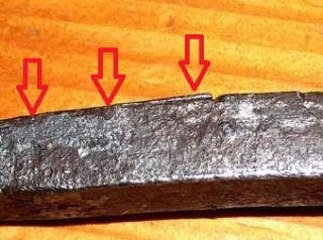
Below: Tony's RR spike found on the Oregon Coast is an instance of how rust patterns tin can suggest the direction of fe fibers in a nail. [Click to enlarge any image]
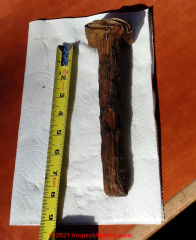
Question: Canadian fasten: estimated historic period 1830 + shows laminar splits forth spike or blast shank
I have a spike that was taken out of the old farm firm where I was built-in and raised . It was located 3.5 miles east of Elmira Ontario Canada. A appointment was inscribed into the basement wall during construction yet information technology was not done clearly.
We cannot decide if it is 1803 or 1863. I was hoping that you may be able to tell when this house was built by this spike.
At that place is a very slight split in the metal about one one-half of the way down the shank.
The head is quite unique as information technology appears to have been crimped down in the corners to create a square on the superlative in a different direction than the base of the caput. Any assistance you could provide would be appreciated. - (Mar 24, 2020) Vern Chiliad
Respond:
Thanks for the interesting nail photograph, Vern. I'd like to encounter a abrupt closeup of the split in the nail.
As I mentioned about a different blast in photos on this page, the fact that the delaminating or split in this nail run lengthwise (parallel to the nail shank) suggest that the boom was of iron whose fibers ran lengthwise, making the nail one probably made afterwards the late 1830s.
For these nails, considering it appears that the two cut/stamping burrs announced on the aforementioned side of the nail propose the blast may have been made afterwards 1840.
- 1830 - present: Mod machine-cutting nails that resemble nails however used today appeared in North America in the late 1830s.
Cut nails were cut from opposing sides, improved or "perfected" machine made nail heads.The presence of auto cut nails is a reasonable indicator that a edifice was constructed (or site occupied) in the 1830'southward or afterwards. (Adams 2002).
Cut nails made subsequently the late 1830s will typically accept:
- smash heads that are uniform and are convex on both sides
- uniformly-tapered shank width or sides
- cutting automobile burrs both on the aforementioned side of the nail
- were made of iron whose fibres ran lengthwise [run across Ashley'southward nail iron fiber and Tony's railroad spike rusty atomic number 26 fibres in photos above], and so these nails can be clinched without breaking off
- will differ little from modern (2019) cut nails
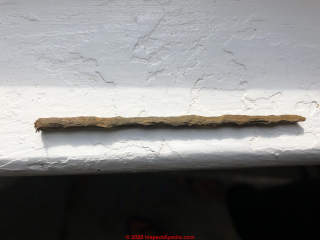 ...
... 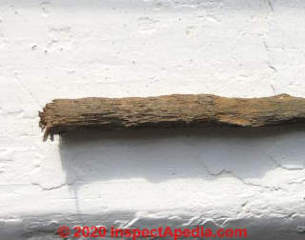
Photos to a higher place: fragments of an fe nail actualization to evidence atomic number 26 fibers running lengthwise forth the shaft of the nail, courtesy of reader Ashley who wrote:
Can y'all requite me your opinion on these two pieces I found. We alive about 700 ft from 1 of the first Northward American settlements circa 1630's. - (April 12, 2020) Ashley
The laminar splits near the boom head propose quondam atomic number 26, likely to have been forged equally early as 1830. - Mod
1832 - Present: Cut Spikes, Railroad Spikes
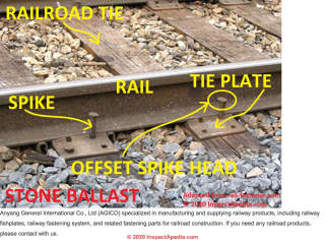 ...
... 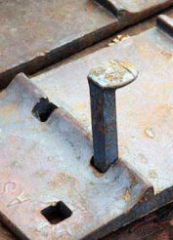
In our images above you'll notice that the head of these large railroad spikes sport an offset head. The larger lip of the first head on these large spikes, also chosen crampons, was used to secure the lesser edge of the track to the steel plate upon which the rail rests.
As the railroad spike is driven through the plate and onwards into the railroad necktie or (sleeper), the combination of spike, tie-plate, and sleeper concord the rail in place in the rock-covered bed (ballast) of the railway.
Details are
at RAILROAD SPIKES
1848 - Nowadays: Original likewise as Reproduction of Antiquarian Nails
- 1848 - Present - Original-utilize and currently reproduction of antique nails, Tremont Nail Company
Details are at TREMONT ANTIQUE Boom REPRODUCTIONS
- 1850 - present: Mod wire-nails (nails that are round in cross-department) appeared in North America in the 1850s and continue to the present.
Round or "wire nails" are produced by cutting a circular fatigued wire into lengths to which a betoken and head are added by the machine.
Details and more images are at WIRE NAILS only below
1850 - Nowadays: Modern Round or Wire Nails
Below, an instance of modern round or wire nails, galvanized fasteners. These 4d 1 ane/two" galvanized nails are designed for use with steel joist hangers.
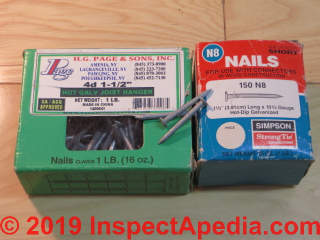
Wire nails were produced in Due north America from about 1850 to the nowadays. Early on wire nails were made starting time in smaller sizes.
If we exclude nails coated with a galvanized or other material, most modern wire-blazon nails will bear witness parallel indentations across the top of the nail below the head, indicating the grip on the nail shank as the nail's caput was formed.
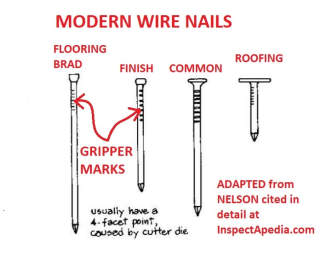
- 1870 - Competition from Wire Nails (circular) - 1870
The Birmingham industry expanded in the following decades, and reached its greatest extent in the 1860s, after which it declined due to competition from wire nails, but continued until the outbreak of Globe War I. (Sjögren 2013) - source: https://en.wikipedia.org/wiki/Nail_(fastener) retrieved 2018/06/15
Ezekiel Reed from Bridgewater Massachusetts developed the starting time motorcar that could cutting a nail including its head in 1 operation.
In the U.Southward. the Parker Mills nail company was built in 1819 on the original site of the Parker Mills cotton manufactory that had been burned by the British during the War of 1812.
 ...
... 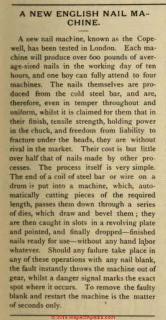
Above: Hardware Merchandising magazine commodity discussing a new English nail making motorcar, 7 February 1890.
[Click to enlarge whatever image]
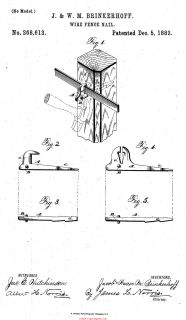
- 1880's - special purpose nails, eg. wire nails and barbed-wire fencing nails using hooked nail heads and sometimes, shank details that resisted inadvertent withdrawal from forest fenceposts but making future removal possible when wire fencing needed to exist repaired or adjusted - shown above the Brinkerhoff wire argue boom patented Dec. 5 1882. The nail head featured details that eased withdrawal of the nail using a hammer.
- Brinkerhoff, Jacob & Warren M. Brinkerhoff, WIRE-Debate-Smash [PDF] U.South. Patent No. 268,813, December 5, 1882
- 1890 - High Volume Production of Cut Nails Continues - 1890
By 1890 nail making mechanism had advanced to produce cut nails at high book and low price and at improved reliability. (Hardware Merchandising 7 Feb 1890)
The Parker Mills nail company became the Tremont Nail company that continues to produce traditional automobile-made "cut nails" today. [1]
The evolution of motorcar made nails that could exist produced in loftier volume was critical to this modify in construction methods. Simply fifty-fifty in the 1930'southward and 40's nails were a meaningful cost of construction.
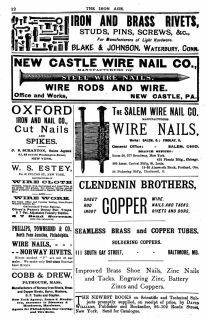
To a higher place, a advertisement for wire-nails appearing in The Iron Age magazine, ca 1893.
- George, Washington. "Boom-staple for barbed wire." U.Southward. Patent i,389,540, issued August xxx, 1921.
1950 - Nowadays: Modern Blast Guns & Ability Nailers
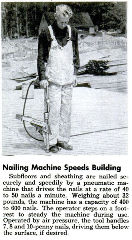
Illustration above: Popular Mechanics, March 1950, p. 96 describing the new "blast gun".
- 1950 nail guns in utilize in woods frame construction. Mod round or wire nails boss nail use in conventional framing and construction, really replaced past nails formed to work in power nailers or "nail guns" for much wood-frame structure.
The boom gun was designed by Morris Pynoos, a ceremonious engineer past grooming, for his work on Howard Hughes' Hughes H-4 Hercules (known as the Spruce Goose). The wooden fuselage was nailed together and glued, and then the nails were removed.
The first nail gun used air pressure and was introduced to the marketplace in 1950 to speed the construction of housing floor sheathing and sub-floors.
With the original blast gun, the operator used it while standing and could nail 40-threescore nails a minute. Information technology had a capacity of 400-600 nails.
- Wikipedia, Nail Gun, retrieved 2019/01/09, original source: https://en.wikipedia.org/wiki/Nail_gun
Analogy below: Paslode nail gun nails sold in strips are still "wire nails" but are no round in cantankerous-department.
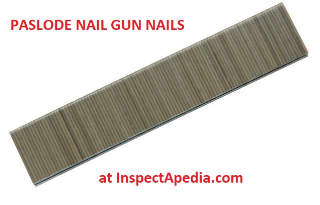
- 2019: modernistic nail guns. Modernistic smash guns are sold in models that operate by compressed air, electricity, or gas cartridges. Manufacturers of nail guns in 2019 include at least the following nailer brands: A.D.I. Atachi, aka ADACHI, AEG, AirPress, Bostitch, DeWalt, Heico,g Hitachi-Koki, Makita, Milwaukee, Paslode, Rigid, Senco, Spit-Impex (concrete nailers), Sumake,
Paslode, a division of Illinois Tool Works, is ane of a number of manufacturers of modern nail guns, sold in both cordless and pneumatic (air powered) models. Paslode was founded by J.Westward. Leslie in the U.S. in 1935.
Supporting Information to Estimate the Age of a Smash
Nails cannot alone give the exact engagement of structure of a building considering the nails themselves may take been made considerably earlier or even re-used from a still-older construction. Simply blast historic period tin can advise appointment boundaries for the construction at a site.
In guessing the age of a boom or other hardware it is very helpful if you can tell us
- Country and city of the building or site where the nails were found
- Age of the building and/or the site if the nails were not in a building or building component. Documents and records providing evidence of the engagement of construction of the edifice or site are the most-reliable dating or crumbling source.
- Age of buildings in the aforementioned area where similar nails are institute
- Technology of production of a specific nail combined with history of the availability of nails produced by a given applied science in the area.
For example in the U.S. machine made nails would take been first most-abundant on the east toll, spreading more slowly across the continent to the west, probably with some nails arriving past ship on the west coast.
- Nail metallic and nail coatings, due east.g. first utilize of galvanized coatings, apply of aluminum nails, copper nails, stainless steel (all modern) vs. wood and iron.
- The mixture of nail types in the building aid identify original construction, modifications, additions
- Proximity to water, to industrial sites, other possible nail sources
- Nail dimensions, or size, and mode (include a ruler in the photograph) tin indicate the nail'south intended use
- Presence of any surrounding material, forest, cloth, etc. where the nail was used.
- Presence of surrounding artifacts that assist date the structure
- Woods lumber or trim or other nailed material species and cutting details can help decide edifice age and nail age also, though wood beams and planks from an earlier building may also have been re-used in a later on ane. See SAW & AXE CUTS, TOOL MARKS, Age
- Nosotros too await closely at the nail iron itself for splitting, machine-cut edges, etc.
Watch out: Documentary sources should have priority whenever possible, and other artifacts should be used equally supportive evidence. (Adams 2002) as cited at NAILS, Age & HISTORY
Watch out: keep in mind that the date of manufacture as well as the appointment of actual apply of nails varies significantly by country and even smaller areas, then the physical location and context of the nail's utilize are important in understanding its probable age.
If we know when a type of boom first became available in the expanse where it was constitute or used and if we know when later on machine made nails were available in the aforementioned area that can set an earliest date for a item nail.
Hand Wrought Nail Details
Details of Mitt-wrought nails used in North America in the 17th, 18th, and 19th century in American edifice construction likewise as modern hand wrought smash reproductions are now found
at NAILS HAND-WROUGHT & REPRODUCTIONS
Inquiry on History of Paw Wrought Nails, Cutting Nails & Wire Nails
This section has moved to NAILS & HARDWARE, AGE Enquiry
where we provide photos, text excerpts & research citations for the history of production and use of nails for various countries including Australia, India, the U.K., Scotland, Wales, The United States, and New Zealand.
Reader Q&A - too see the FAQs series linked below
@Rick Craig,
Our almost-complete advice on guessing age at
NAIL AGE DETERMINATION Central
https://inspectapedia.com/interiors/Determine-historic period-of-old-nails.php
Please do have a look.
@sophia,
It's worth noting the management of that split up in your rusty iron fasten or nail: parallel to the shank. We cite that item in
Boom AGE DETERMINATION KEY - utilise this key to guess at the age of your boom or spike
https://inspectapedia.com/interiors/Determine-historic period-of-former-nails.php
we found a quondam smash on our school grounds whilst excavation a hole.nosotros remember its from the early on 1900s but we're not sure

On 2022-05-01 by Inspectapedia Com Moderator - square headed tapering nails with center rib found in 1869 farm house stairs
@Kami horricks,
The straight -tapering sides on that prissy nail and that raised center rib tell us something about its era of production
Details are at NAIL Historic period DETERMINATION KEY - use this primal to guess at the age of your nail or spike
Hello! We are attempting to prove age on our farm house. The human action says 1869 only I have plat records showing a dwelling in the aforementioned spot going back to 1855 as well every bit the grant records of the original owners and settlers of our sector of our town ship( not its not an amazing discovery but I'm enthralled with information technology lol)
I am convinced our kitchen area was the original habitation. A log cabin. Our stairs accept these nails in them. Could you help me date them? I've had a hard fourth dimension matching them exactly. The photo shows a side view of an unabridged nail as well as the head of 1 notwithstanding Installed. Much appreciated!!!

@Charles,
12 millas a reasonable guess. More details see
NAIL AGE DETERMINATION Cardinal
https://inspectapedia.com/interiors/Determine-age-of-erstwhile-nails.php
Included at that place are some specific smash comparisons including ascendancy nails, using some reproductions and measurements as examples.
Delight take a look and let me know what you think.
I plant an erstwhile smash thats is apx 2 in long, with a hexagonal rectangle caput. People in the Colorado rockies with nails were abundant from 1858 onward. May exist a clout blast? Any help with identifying its employ or age would exist appreciated

@Joan Jorgensen,
Unfortunately that boom is so rusted every bit to offer only a few clues about its history:
- await for any splits forth the length of the shaft as a clue about iron fibre directory (details to a higher place on this page)
- examine that round head for signs of motorcar fabrication
Hi nosotros found this 3" mail in our back one thousand in Green Valley, due south of Tucson, AZ.
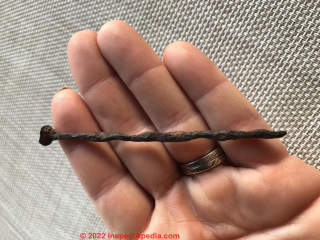 ...
... 
@Michael,
I doubtable that the fasten has lost and then much of its body past rust that we won't notice tool marks or cutting marks that might aid requite its age though the mitt forging you see help dominion out machine cut spikes.
What's left and so are guessing history by the surrounding context: history of activities in the area, types of structures, altitude to the De Cymru coastline (possible dock or send spike?) or to large wood structures (barns?).
You volition observe our most-complete advice on guessing age at
NAIL Historic period Conclusion Cardinal
https://inspectapedia.com/interiors/Make up one's mind-age-of-old-nails.php
where yous'll read, when estimating the age, properties, apply, and history of a metal fastener like a nail, spike, or spiral, we wait
1. at the item itself for clues almost how it was made, of what materials, and in some cases iron fibre direction that tin bracket age of manufacture
ii. at contextual clues: what we know from surrounding materials, location, history of the area, etc.
Hi. I found this in S Wales. This seems to predate my other finds so was wondering if anyone can shed some low-cal on this. It's 18/19cm long. The head is almost rugby ball shaped and appears to take been hand forged? Thanks

@Cowin,
Thanks for the added detail.
Those regular nail shanks, absenteeism of tool marks, and the regular burrs forth the shank edges also suggest mod product. Can you say whether those are bronze, or now that I look again, fe, or what is the metal?
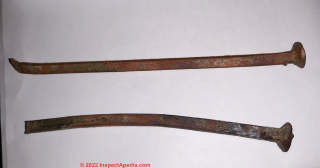 You volition find our near-complete communication on guessing age at Boom AGE Decision KEY https://inspectapedia.com/interiors/Determine-age-of-former-nails.php
You volition find our near-complete communication on guessing age at Boom AGE Decision KEY https://inspectapedia.com/interiors/Determine-age-of-former-nails.php
And you might try Google image search or a google search on any boom codes or letters yous are seeing in the nail caput.
It's worth a google search - be sure to include the state and city closest to where found when doing a search.
Sorry not sure what y'all mean. I don't think they are bronze. I was wondering if they can be identified by the headstamp. Maybe english 1800s?
They are only effectually 12cm in length
[Photograph above]
@Cowin,
Those look like twentieth-century spikes that might take been used on a ship or a dock
How-do-you-do. I found these 2 nails in eastern NSW site. Tin y'all please aid me with identifying them? Ane has what looks like a diamond shape caput stamp and the other looks like either an L or the number seven.
Please see attached picture

@Andrew Cowles,
Cheers. Dainty photo.
The caput suggests a fairly mod auto made decorative nail.
Hi Guys,
I found this interesting Iron blast in my garden. It's square and seems hand forged, but has a nice domed copper caput.
We're in the U.k.. Whatsoever idea what catamenia it would be from?
Many cheers,
Andy
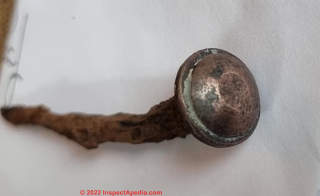
@inspectapedia.com.moderator, I found this spike metallic detecting in MO. Anybody can assistance me appointment information technology. Four sided spike
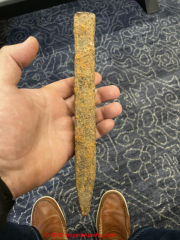
@Simon,
You can see our nearly-consummate communication on guessing age at
Blast AGE DETERMINATION KEY
https://inspectapedia.com/interiors/Determine-age-of-quondam-nails.php
The bluish origin however is another question and one I don't take an reply for.
Drift wood with single blast. Trying to institute historic period and possibly blue origin
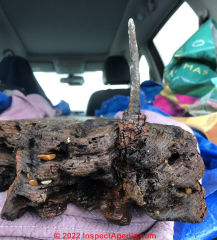
Found in very sometime stone wall ? Any ideas? Located in Massachusetts
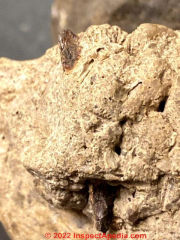
@Steve Campbell-Wright,
The round upper shank of your blast makes it a mod fastener.
Be sure to run into the boom ID and historic period tips given at
NAIL Age DETERMINATION KEY - utilise this key to guess at the age of your nail or spike
I am hoping to identify this nail. It is 3 inches long with a head dia of 9/16". The upper role of the shank is round, and the lower office is forged to a rectangle with a chisel point. There is a 'W' forged into the countersunk head.
What is its purpose, and how old is information technology please?

@Jason Chiliad Gould,
I'm not certain what you mean by molded nails, merely if you hateful round wire nails, their history is included in the page above.
@danjoefriedman, thanks!
When did the moulded (molded?) nails go popular and so?
@Jason Thou Gould,
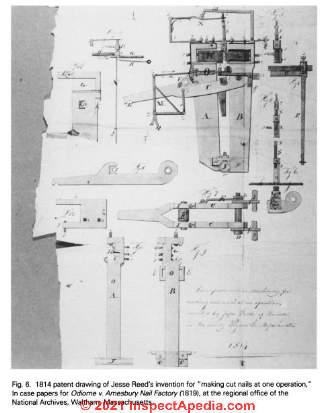 It certainly has merit. Nails were cut from forged blanks, even past paw-operated machines at to the lowest degree from the early 1800s and maybe as early as 1790. (How, 2018 & How, 2009 ) (Phillips, 1993).
It certainly has merit. Nails were cut from forged blanks, even past paw-operated machines at to the lowest degree from the early 1800s and maybe as early as 1790. (How, 2018 & How, 2009 ) (Phillips, 1993).
Cutting nails were valuable, and in addition to being made past small hand operated machines would accept been imported from England, from France, and perhaps also made further W in the U.S. or shipped to that coast.
@Jason M Gould,
Continuing, Phillips notes that
By 1788, Adam Rogers, of Marshfield, had adult a machine that "cut nails from hoops or plates," and by 1792 his nephew, Samuel Rogers, was cut nails "past hand in a small machine invented by him.
When cut from nail plate, the nails produced by the mitt-operated machines would probably accept had characteristics like to those of nails manufactured a few years afterwards, but with less refinement.
The primeval cutting nails would have had shanks with 2 tapering and two parallel sides and burrs on diagonally opposite edges (having been cut from the aforementioned side of the nail plate), like their later cousins.
Nevertheless, because of the crude, somewhat uncalibrated method of cutting, the shanks in cross-department would probably have appeared as skewed rectangles or parallelograms, rather than true rectangles (Fig. 2).
The nails would have had rounded ends (from the edge of the nail plate) and were probably initially hand-headed, sometimes with faceted rose or "T" heads found on wrought nails, other times the upper end simply bent over to produce a brad.
Eventually, crude heading machines may have been used.
Below, courtesy of Phillips (1993) is an illustration of the 1814 Reed Cut Blast Auto patent, found in the patent infringement lawsuit papers in Oiome v. Amesbury Nail Factory (1819) at the regional part of the National Archives, Waltham MA.
My grandfather and his siblings and parents were part of the Klondike gold rush, 1898-1904. He wrote in a newspaper, decades later, about his father's mining grouping, "While on the prospecting trip the party went into the Duncan Creek area which later became the fabulously wealthy Keno Hill and Mayo country. Here they found sluice boxes nailed with nails that had been cut rather than moulded.
This indicated prospectors had been in that area in the early on '70's and '80's – long before the Klondike strike in 1896."
Do you have whatsoever idea if this statement has merit? And do you know what types of nails would have been used during the 1896-1899 timeframe in Yukon Territory, vs. earlier than that?
Give thanks you lot!
@Christian Manalo,
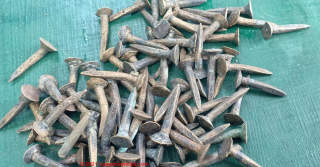 To get a general idea of the composition of those tacks or small nails
To get a general idea of the composition of those tacks or small nails
ane. utilize a magnet - to run across if they're iron or steel vs. mayhap brass or some other non-magnetic metal
two. scrape the surface to see if y'all discover shiny brass or copper
From just the photo they look similar galvanized fe
@inspectapedia.com.moderator,
Can y'all identify what metal been used on these nails. My brother constitute these on unknown wooden shipwreck buried in the sand along the shore in the Philippines.
@Hugh Dickman,
in the live links above please cheque out
NAIL AGE Determination KEY - use this central to guess at the age of your blast or spike
Hey was wondering if you tin can age these nails
@Sue,
What I can encounter in the photo is a four-sided iron fastener, not necessarily a nail, and as yous say it'due south embedded in a piece of iron strapping, information technology could have been a bolt. I can't offer a more than-useful annotate;
Only at
Smash Historic period DETERMINATION Key - utilise this key to approximate at the age of your nail or spike
https://inspectapedia.com/interiors/Determine-historic period-of-former-nails.php
you will meet that we provide a list of questions that you tin can endeavour to reply that give what I call contextual information well-nigh your metal find that tin can aid guess at its apply and history.
I found this piece of atomic number 26 with smash in. Is it possible to date/proper name this type of nail please. Found near harbour in Scotland/Britain
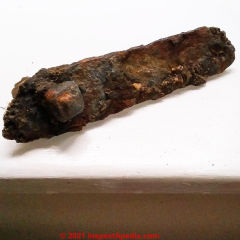
@Eleanor,
In the article in a higher place you we should be certain to read the section on the direction of iron fibers equally a break point in crumbling Nails
Clinched Nails could not be bent over without breaking until iron fibers were fabricated to run parallel to the length of the nail.
I am interested in the age of these 'split nails'. Information technology is an old oak door and at attaching the bolt on the other side of the door.
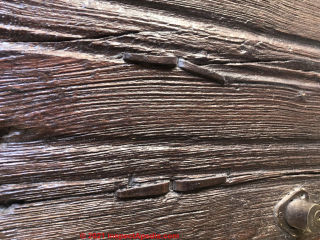 .
.
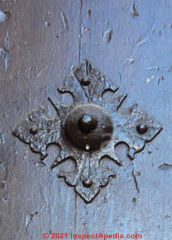 Cheers for the photo.
Cheers for the photo.
Very nice; looks similar brass or copper; am I right?
A bulbous headed tack / nail of matchstick size might have been used where its head was left exposed to view, such every bit a decorative nail in a door or other edifice feature; smaller gauge tacks with decorative heads likewise show up on upholstered piece of furniture.
Any information about the history of the specific site in the Hague might give us more than clues.
To go WAY back you lot might enjoy seeing
Butler, J.J., BRONZE AGE METAL and AMBER in the NETHERLANDS [PDF] University of Groningen Library, Netherlands, retrieved 2021/08/30 original source: https://ugp.carpet.nl/Palaeohistoria/commodity/download/24902/22350
@Andrew Wills, here's an excerpt from a photo of a wooden door with metallic decorations that might include bronze seedling-headed brusque nails.
In addition to all the information about erstwhile nails on this folio, I encourage you to run across the information and examples at the following articles:
Antique Smash Historic period & History FAQs Q&A on Nails as Indicators of ...
inspectapedia.com/interiors/Age-of-Nails-FAQs.php
and
Age and History of Antique Nails
https://inspectapedia.com/interiors/Decide-age-of-old-nails.php
Howdy - I establish the nail shown in the attached image in a friend'south garden in The Hague in the Kingdom of the netherlands. Any information about its history would be much appreciated.
Many thanks
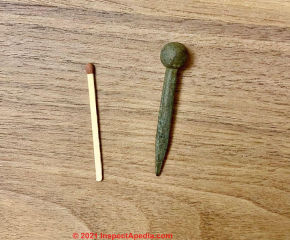
@Leslie Weyhrich,
Bear witness us a photo of raisin head nails and tell usa what y'all tin about the product - that may assistance locate the box you want.
looking for an original box of raisin caput nails don't need the nails just the box!
@Brook,
Give thanks you for the interesting photos and for your question. Nosotros tin't see enough nor practise we have whatsoever other contextual information to say more than there appear to be a couple iron fragments. With respect to age, in that location are some clues in the article above. Too see:
Age and History of Antiquarian Nails
https://inspectapedia.com/interiors/Determine-historic period-of-old-nails.php
I found these recently on ii split up beach walks. They look handmade but I'm not sure what I have here. Whatever ideas?
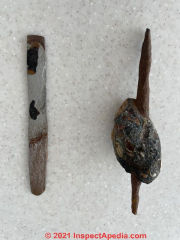
@Whitney Tomlin,
In addition to all the data nigh old nails on this folio, take a wait at the following page and its easy questions to aid decide nail historic period:
Age and History of Antique Nails
https://inspectapedia.com/interiors/Determine-age-of-old-nails.php
Yous may also enjoy examples from other readers' 'finds' at:
Antique Boom Age & History FAQs
inspectapedia.com/interiors/Age-of-Nails-FAQs.php
Hi! Wondering if y'all all might be able to help me determine the age of an old farmhouse I'chiliad currently working on. I accept managed to pull i of the original nails out without dissentious the nail too much. Please accept a expect at the prototype and let me know if you have any idea. Cheers!
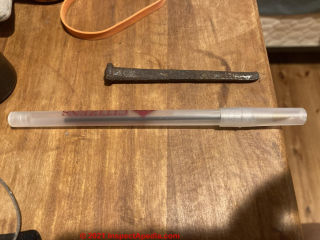
@Anonymous,
Sure, in the article to a higher place accept a look at the description of cut nails.
Nosotros are doing a roof to a house that got finished in 1905 the rumor is the firm started being built in 1901 at that place has been simply 2 people to own the identify...nosotros found a few of these nails it looks similar the same style nails in the picture show that says they are vintage can someone assistance me to run across what kinda nails these are?
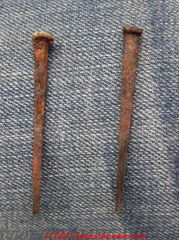
@Keith,
That is certainly a remarkable Fasten. I don't know what it was for. Perhaps Timber framing.
Sometimes people cut grooves in the spikes to improve their resistance to withdrawal but more-likely their regularity suggests that those are grip marks left by mechanism used in nail or spike production.
I establish this metal detecting on an old rural Nova Scotia property. Whatever idea how old it is? What are the grooves for? Measures three/iv" square and virtually 5 3/four" long
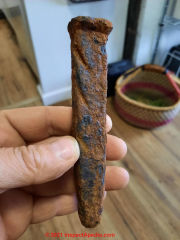
@RoboElv,
The uniformity and class of those tacks and the fact that a black coating remains on them all look "modern" to me.
Keep in mind that tack-making machines are among the oldest of automobile-made nails and fasteners.
@inspectapedia.com.moderator, Thanks I did wonder that although they seem quite mesomorphic and solid. Given the pyramid head on them someone did suggest they were "old style decorative Iron door, gate woods studs arts and crafts nails". I fabricated a mistake on the starting time message to, they are 30mm top to bottom.

@RoboElv,
Perhaps upholstery tacks, those are big-head motorcar-made tacks. Probably modern.
I don't know if they are old or not although we have had a cloth sack of nails in the back of diverse garages for at to the lowest degree 50 years, The heads are around 2cm across and the smash 2cm long. The heads are round although accept a cross event on them with the centre existence raised.

@Susan Row,
That looks like a modern cut-nail, and those diagonal indents may be artifacts of the blast-making auto's gripping mechanism.
In addition to all the information about sometime nails on this page, I would suggest the following commodity which will give yous several piece of cake questions to aid determine the age of this smash. Especially as it was role of your grandmother's manor, you lot may accept relevant knowledge as to its age as you look at these questions:
Age and History of Antique Nails
https://inspectapedia.com/interiors/Determine-age-of-erstwhile-nails.php
And there are examples from other readers' 'finds' at:
Antique Boom Historic period & History FAQs
inspectapedia.com/interiors/Age-of-Nails-FAQs.php
Please let united states know if you have additional questions.
Recently I had a woods frame repaired. It came from my grandmother's manor. The man who did the repairs gave me one of the tiny nails that he had to remove, because he thought it interesting and very one-time. It has iv sides and is distinctly rectangular. How accurately can its historic period exist determined? Information technology is ane inch long.
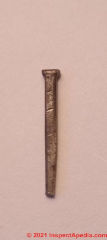
@Bill,
That nail is quite rusted merely it looks as if the shaft and head were hand-forged; have a look nether magnification to see if there are whatever splits that indicate direction of atomic number 26 fibres. Then encounter:
Nail Historic period Determination Key - use this key to guess at the age of your nail or spike
Contains our all-time suggestions for maiming surrounding contextual data and making physical observations that will assistance yous guess at the age of a smash or Spike
How-do-you-do, I constitute this nail near the site of the old Boonton Iron Works / New Jersey Iron Company site (operational late 1700's to 1911. It'south ii.5" long and the caput is 0.v" beyond.
Tin can you lot please aid me understand a bit more than virtually information technology? particularly interested in knowing how onetime it is. Thanks, Beak
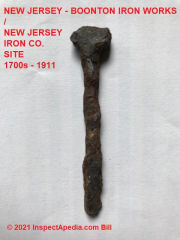
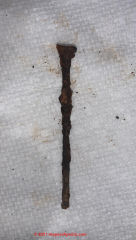 @East,
@East,
In improver to all the information near old nails on this page, you may enjoy learning some new facts and examples at the following articles:
1) AGE AND HISTORY OF ANTIQUE NAILS
And there are examples from other readers' 'finds' at:
2) NAILS & HARDWARE, Age FAQs Q&A on Nails as Indicators of Edifice Historic period
Hello! I recently plant this blast while out metal detecting. Do you mayhap know how old it is? Thank you so much!
@Hollywood Hills trail,
Hi!
I found this I retesting nail up in the Hollywood Hills in Bronson Canton below the Hollywood Sign (not under information technology, just at the base of operations of the trail).
Any idea of how old it might exist?
Dave
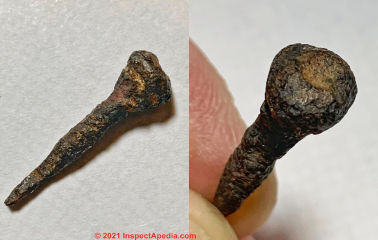
@inspectapedia.com.moderator,
The nails get into the paper... simply that doesn't mean that the paper wasn't onetime when the nails when into it.
The merely other visible hardware on the frame are some eye-bolts holding the wire/cable to hang the (heavy) frame. The cable looks old-but 'modern.'..similar to electric wires that used to be insulated on the outside from maybe the 1920'southward ish).
I tin can say that I was trying to take photos of all four sides of the nails that I had wiggled out-- I noted that the smaller has a pocket-sized twist in it.. like it didn't quite lay apartment as I turned it onto 2 of it'due south sides.
I might simply have to look until I see a need to actually reframe. It's pretty nice the style it is.
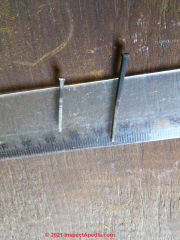
@Denise,
Are you confident that those nails are original - and thus similar in age as the newspaper?
Are at that place other types of nails in the aforementioned frame?
Those nails look quite straight - if they're cut they may be more modern than we outset guessed. Are there any burr marks for cuts on the nail edges?
This is a prissy instance of using contextual bear witness (newsprint) to help date an object similar an old nail.
These nails are property on the back console of the frame holding a lithograph I recently bought at a second hand shop.
While not necessarily of the same timeline, the lithographer is from Berlin, the benefactor, New York. I just purchased information technology in Oregon.
The edges of the newspaper (that I tin see) beneath the framing have American spellings, and there is a reference to Ellis H. Roberts (a politiician of the 1870's) - I've not removed the whole console to go a appointment from the newspaper as I don't want to mess with the framing but to satisfy my marvel.
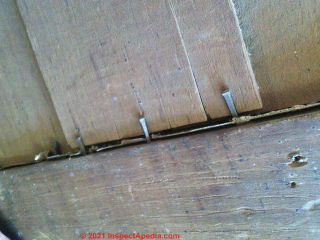
@J d byers,
Nice. What else do we know: country, urban center, location of find, blast dimensions, backdrop, appearance, age of buildings nearby? Photos?
Nosotros found a nail that has J on the head
@Joshua,
Looks as if information technology may be only information technology's then badly corroded it's lost a lot of the original material and so its clues.
Across looking just at that spike or nail, see the age-guessing help at NAIL AGE DETERMINATION Cardinal
https://inspectapedia.com/interiors/Determine-age-of-old-nails.php
If it'due south a railroad spike it's probably motorcar-fabricated.
See also RAILROAD SPIKES
Is this nail hand forged?

Question: Are these old nails in this old arrow-shaped stone? Kinagoe Bay, Ireland
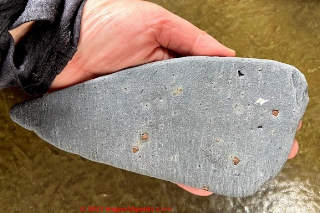
[Click to overstate any paradigm]
Apr 13, 2021, to editor
I am wondering if you can assistance me.
I institute this, done aground, on Kinagoe Bay on the northwest coast of Republic of ireland this week. We liked the pointer shape so took information technology home & since noticed what looks like nails?
Would anyone have any ideas what this might have been?
Could it be off an old ship?
Or house?
Moderator answer: no
I'd like to meet a sharper close up of what yous retrieve are nails, and I would similar to know the thickness of the material and whether or not the suspected nails prove up on the other side of the stone and too to come across what that side looks similar.
Another affair to look for if this is an artifact would be marks on the rock indicate that information technology was a worked material as opposed to a naturally occurring material and another would be to ask whether that particular kind of rock is something that occurs naturally in the area and whether or not you tin can detect other pieces of the same cloth.
It seems possible that you are seeing an fe or other metal inclusion that occurs naturally in some stone merely I really tin can't make out enough from the photos that y'all sent.
Reader follow-upward:
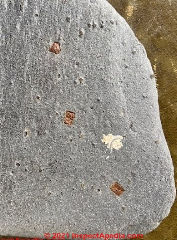
This might help place the stone.
I am attaching a few close upwardly photos of what I think are nails? [Photos higher up and below]
Two can exist seen through the other side just no bodily point of boom. They don't wait natural.
Stone is shine, most worn & weathered.
I have no idea what type of stone it looks like.
I picked it up considering it looked similar an arrow & afterward we noticed the markings.
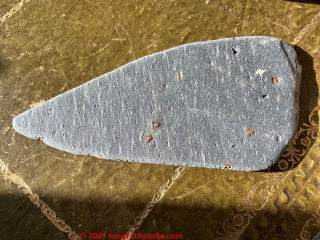
It came in with the high tides we have had lately.
It was on Kinagoe Bay...off the Inishowen coast headland where the Trinidad Valencera sank. Photo below of Kinnagoe Bay, Ireland courtesy Google Maps
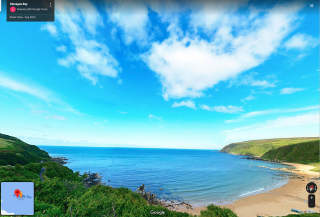
That'south easy to find online then i of your readers may know the stones/tiles etc of that surface area.
I would be more than happy for it to be posted.
I'thousand very curious & love the history of 'everything & annihilation'!
It's 5mm [thickness ? - Ed.]
Moderator reply: Potassic feldspars or similar inclusions in rock may look rectangular and iron-colored just are not nails
I'thousand non a rock authority but I suspect that what nosotros're seeing are not nails only crystalline inclusions in the rock that occurred naturally.
Roberts (1975) has described the geology of the Kinnagoe Bay area of Republic of ireland as does our Irish government document on North Donegal's geology cited below.
Your stone is probably blue-grey phyllite, naturally polished smooth past wind, h2o, sand.
My reasoning includes these observations:
one. Irregular non all smash-head shaped; the reddish dark-brown "things" are non all the same size and not all rectangular.
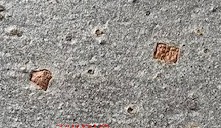
2. No tool marks: at that place are no signs of having been hand worked such as hammer marks or tool marks
3. Fit in surrounding stone: they fit perfectly and absolutely tightly into the stone - not something hands achieved if drilling or boring a hole in rock through which we plant to insert an atomic number 26 fastener
4. Natural stone surfaces: the rock itself doesn't wait as if it'due south been worked-on - no tool marks, perfectly smooth surface
5. Location in stone not associated with fastening a rock tool to a handle or like use.
Some of these iron-like inclusions in your stone are at very minor and fragile stone locations similar the stone tip - not a functional location at which someone would have tried to insert a boom [Photo below]
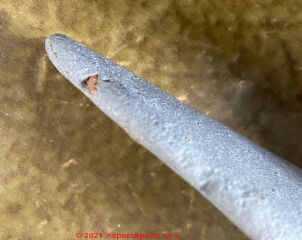
But of course there are other observations (or experts) that (who) could change that opinion.
It would be informative to probe one of those inclusions to make up one's mind its hardness and information technology would be interesting to remove one to come across if it'southward in fact atomic number 26 (not that at that place couldn't be fe and magnetic inclusions).
Below are examples of inclusions found in concrete every bit well as naturally institute in other stone; some of these tin can be quite rectangular. Detect nevertheless that their location in the concrete or stone is not regular.
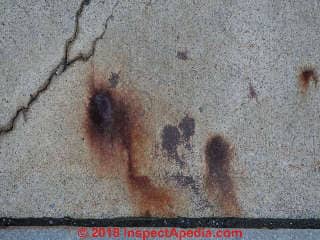
Photo above of fe-like inclusions in concrete is from the article cited immediately below.
- FOUNDATION DAMAGE by MATERIAL or INCLUSIONS - InspectApedia.com commodity
- Bryant, Lee Davis. " Geotechnical problems with pyritic stone and soil." (2003). [PDF] Thesis for MS in Civil Engineering, retrieved 2017/08/03, original source: https://theses.lib.vt.edu/theses/available/etd-05212003-173107/unrestricted/ThesisAll.pdf
- NORTH DONEGAL - County GEOLOGICAL SITE REPORT [PDF] Government of Ireland, Department of the Environment, Climate and Communications, 29-31 Adelaide Road, Dublin 2, D02 X285 Website:www.gov.ie/decc
Email:client.service@decc.gov.ie Telephone number:01 678 2444
retrieved 2021/04/17 original source: https://secure.dccae.gov.ie/GSI_DOWNLOAD/Geoheritage/Reports/ND006_Kinnagoe_Bay.pdfExcerpts:
Kinnagoe Bay comprises a scenic and sheltered strand at the human foot of a steep plunging cliff and bluff lined coast at the head of a wide bay. The cliffs and bluffs are thickly vegetated with scrub and trees, with vegetated dunes areas at the dorsum of the beach.Geological System/Age and Principal Rock Blazon
The beach and back beach dune organisation have adult in the last 12,000 years since the end of the last Ice Historic period, and is Holocene in age. Coastal bedrock exposures of Dalradian Supergroup dust and phyllite (similar to slate) crop out in the intertidal zone at discontinuous sections along the embankment, with many outcrops polished shine past air current-blown sand.
The embankment likewise exhibits fine examples of sand-blasted rock, as seen on the blue-gray phyllite outcrops on the embankment (663010E 945900N).
At the western end of Kinnagoe Bay, in the vicinity of the car park, fibroid graded grits and phyllitic slates are extensively reddened. This colouration feature is uncommon in the Dalradian rocks of Inishowen and Donegal.
In 1980, a diving expedition to the wreck of the La Trinidad Valencera retrieved a embankment pebble (crimson/orange calcareous mudstone) of the foreshore below the coastguard station, containing a small (31mm) ammonite of the Lower Liassic genus Echioceras. The pebble is understood to be glacial droppings, and not local.
Early on OSI 25" sheets record a disused lime kiln near the gully at the westward end of the beach cliffs.
- Potassic Feldspars*: (microcline, orthoclase) Potassic feldspars are pink or tan, sometimes white. They show apartment, shiny faces in igneous rocks. The crystal grains are usually blocky and nearly rectangular. http://www.minsocam.org/msa/collectors_corner/id/rock_key.htm
- Roberts, J. C. "Reddened Rocks in the Upper Dalradian Succession of North-Eastern Inishowen." The Irish Naturalists' Journal (1975): 136-140.
Abstract:
Reddened rocks are described from strata of Upper Dalradian age in n-eastern Inishowen. The field occurrence of the reddened strata suggests a diversity of origin whilst their association, at to the lowest degree locally, with thick feldspar conglomerates is considered to be significant, and must bespeak either temporary shallowing or strongly oxidizing conditions in the depositional area.
-----
...
Continue reading at Boom AGE Decision Primal questions & answers, or select a topic from the closely-related articles below, or see the complete ARTICLE INDEX.
Or see NAILS & HARDWARE, Historic period FAQs - questions & answers posted originally at this folio and additional photos of old and newer nails
Or run across these
Recommended Manufactures
- AGE of a Edifice, HOW to Determine - home
- DOOR HARDWARE AGE
- NAILS, Age & HISTORY - home
- Nail Age DETERMINATION Primal - use this key to guess at the age of your boom or spike
- NAIL ID & Age: CUT NAILS
- NAIL ID & Historic period: HAND FORGED NAILS
- Blast & HARDWARE CLEAN-UP
- NAILS & HARDWARE, AGE RESEARCH
- RAILROAD SPIKES
- SAW & AXE CUTS, TOOL MARKS, Age
- WINDOW HARDWARE AGE
Suggested citation for this spider web page
NAILS, Age & HISTORY at AuditApedia.com - online encyclopedia of edifice & environmental inspection, testing, diagnosis, repair, & problem prevention communication.
Or see this
Alphabetize to RELATED Articles: Article INDEX to BUILDING AGE
Or utilize the SEARCH BOX found beneath to Enquire a Question or Search InspectApedia
...
Ask a Question or Search InspectApedia
Try the search box merely below, or if you prefer, mail a question or comment in the Comments box below and we will respond promptly.
Search the InspectApedia website
Note: appearance of your Comment beneath may be delayed: if your comment contains an image, web link, or text that looks to the software as if it might exist a spider web link, your posting will announced after it has been approved past a moderator. Apologies for the delay. Our Comment Box is provided by Countable Web Productions countable.ca
Technical Reviewers & References
Click to Show or Hide Citations & References
Publisher InspectApedia.com - Daniel Friedman
Source: https://inspectapedia.com/interiors/Nails_Hardware_Age.php
Posted by: lononmarted1980.blogspot.com

0 Response to "When Were Round Head Nails First Used"
Post a Comment